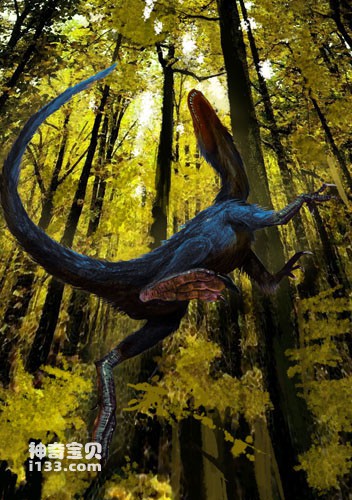Sinosaurus lived in the Early Cretaceous about 140 million years ago. When its fossils were first discovered, it was thought to be a primitive bird. Later, paleontologists confirmed it to be a small carnivorous dinosaur. Its initial skeleton was about 1 meter in size, with short and thick forelimbs, sharp claws, and long hind legs, suitable for running. Sinosauropteryx's spine and body surface had a tassel-like fibrous structure, which was a layer of primitive down. This structure may be the predecessor of feathers. It has no flying function and is mainly used to protect the skin and maintain body temperature.
In 1996, an explosive discovery came from Shangyuan Township in Beipiao, Liaoning, China. The world's first dinosaur with velvety hairs (fibrous skin derivatives) was discovered! This dinosaur had a large head, a body size similar to that of a chicken, short forelimbs, and long and thick hind limbs. The sharp teeth in its mouth indicated that it was an active predator. In addition to long hair, it also has a particularly long tail composed of up to 58 tail vertebrae. The square bones of its head have not yet healed, and it has 4 cervical vertebrae and 13 vertebrae. Its tail is almost 2.5 times the length of its trunk. It belongs to the theropod family. The discovery of Sinosaurus fossils is one of the most important discoveries in the history of dinosaur fossil research in the past 100 years. It is of immeasurable significance not only for studying the origin of birds, but also for studying the physiology, ecology and evolution of dinosaurs.
When a large number of dinosaurs retired from the stage of history in the late Mesozoic Era, people believed that this kind of dominant reptile was completely finished. In fact, dinosaurs are not extinct. One or several of them are trying to leave the land and develop into the air. Pterosaurs were the first to have wings for flight, but they had no real feathers. Pterosaurs had very broad sternums and had keels like birds, but they could not fly long distances and were not conquerors of the air. They disappeared from the earth before they became true fliers. Who is the conqueror of the air?
Birds appeared.
The origin of birds is one of the major unsolved problems in the scientific community. As early as more than 100 years ago, paleontologists discovered Archaeopteryx in Germany. In order to further reveal the secrets of the origin of birds, paleontologists have made unremitting efforts, but until now, a total of 10 Archaeopteryx fossils with varying degrees of preservation have been discovered, which have become the entire basis for humans to describe the origin story of birds. Did birds evolve from dinosaurs? How did birds evolve and develop? It is difficult to conduct a comprehensive and in-depth study based on the limited materials of Archaeopteryx.
The discovery of Sinosauropteryx provides us with new evidence of the evolution from reptiles to birds. After research, paleontologists in my country pointed out that Sinosauropteryx not only retained some characteristics of small theropod dinosaurs, but also had some basic characteristics of birds, becoming an intermediate link in the evolution of dinosaurs into birds. The "feathers" of Sinosauropteryx are flake-shaped and have feather rachis. These feathers are structurally different from those of modern birds and represent the initial stage of early bird evolution, which is more ancient and primitive than Archeopteryx in Germany.
The skeletal characteristics of Sinosaurus are like those of dinosaurs: a larger head, teeth, a large number of tail vertebrae, and agile movement, but it does not yet have the ability to fly. But based on the important feature of being covered with primitive feathers, it may be classified as a bird rather than a dinosaur, because reptiles are covered with scutes or scales. Birds wear feathers to maintain body temperature and facilitate flight.
The strata that preserve fossils such as Sinosauropteryx in the Beipiao area of Liaoning Province record rare events that have occurred in geological history. Precisely because the probability of occurrence and discovery of this geological phenomenon is very low, it is extremely rare and precious.
The discovery of the Sinosauropteryx fossil and its value will naturally attract more and more attention from the scientific community. With in-depth research on Sinosauropteryx, the secrets of bird evolution and development are being revealed step by step.

Chinese name: Chinese dragon bird
Latin name: Sinosauropteryx
Age of survival: Early Cretaceous
Fossil origin: Liaoning, China
Physical characteristics: 1.3 meters long
Diet: Carnivorous
Species: Theropod
Definition: Bird-like dinosaur from China
animal tags: Sinosauropteryx
We created this article in conjunction with AI technology, then made sure it was fact-checked and edited by a Animals Top editor.